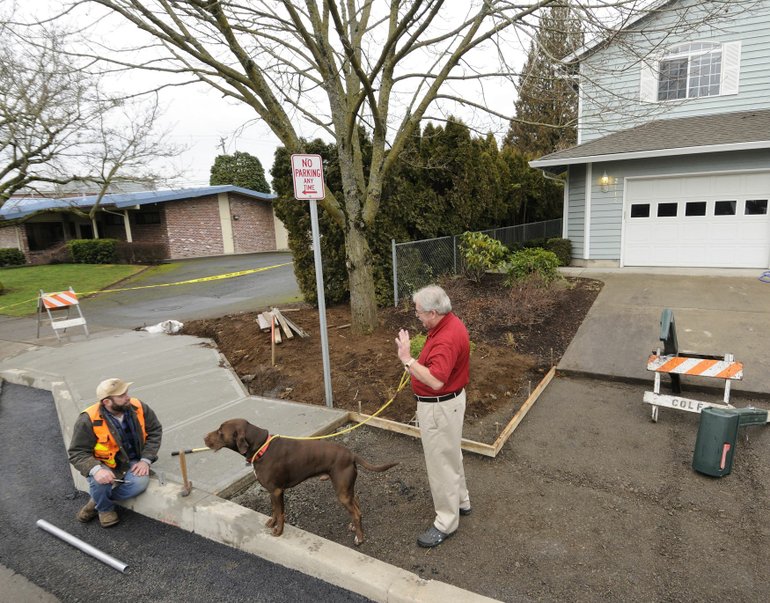A busy stretch of East McLoughlin Boulevard has become a lot more pedestrian- and bicyclist-friendly with completion of a long-awaited section of sidewalk near Clark College.
Hired by general contractor Colf Construction, workers for Van Lom Concrete last week poured a full-sized sidewalk and new driveway entrances.
They filled in the missing link on McLoughlin’s north side between East Reserve and W streets, improving safety for walkers, motorists and cyclists who travel the corridor between the college and Grand Boulevard, passing the Washington State School for the Blind.
They also won high praise, along with Vancouver city officials, from a resident whose prized maple tree was saved with a late design change.
The project was funded with a $150,000 Community Block Development Grant, and meets the Central Park neighborhood’s long-stated goal of a full-length, north side McLoughlin sidewalk. Two years ago, crews improved and filled out the section to the east and uphill, between X Street and Grand Place, also paid by a CBDG grant.
The missing walkway had become a glaring safety issue, never more so than in the past year. Soaring Clark College enrollment has sent many commuting students flooding into nearby residential streets for parking.
On most school days, between 15 and 20 students would tuck their vehicles along McLoughlin’s north side, where the walk was just added. Rather than cross to the existing south sidewalk, they would trudge in the narrow space between the parked cars and westbound traffic, joined by others who parked on side streets. Fencing, thick hedges and other obstacles barred off-pavement passage.
Add a steady stream of auto traffic, C-Tran buses and many cyclists who zoom downhill from Grand Boulevard, and it wasn’t a pretty picture.
Like other McLoughlin residents, Chris Peterson favored the new sidewalk. He also had tired of having his mailbox blocked and his view obstructed as he carefully backed out of his duplex.
One problem: While the rest of the new sidewalk would be poured out on McLoughlin itself — eliminating the parking strip for daily visitors, but also sparing residents losing part of their front yards — planners intended to curl back across Peterson’s narrow parcel, where a couple of old concrete slabs delineated a footpath in line with an existing sidewalk next door.
When Peterson saw orange paint striped on the not-quite-mature maple next to his driveway, he pled for help, writing Dick Malin, Central Park Neighborhood Association president, and the city.
“Saving the tree was huge, in my mind,” Peterson said. He pointed to an upstairs bedroom window with full southern exposure, same as the duplex’s other half that he owns and rents out. He knew the city would replant a smaller tree if the sidewalk unseated the maple, he said, “But I’m 65 years old, and I will never see any shade from that tree.”
Reaction was swift. Malin visited the next morning and agreed the tree shouldn’t go. Vancouver sent a city arborist, who concurred, judging the maple could survive quite nicely even if some surface roots that had been trampled by pedestrians would have to be removed.
“The city immediately changed the plan,” said Peterson, a retired Oregon law officer who now runs a private investigation firm. “I’ve dealt with government bureaucracy a lot of years. I just can’t say enough good things about the response I’ve gotten from the city, and the contractors. It’s not always that way, as we all know.”
The fresh sidewalk bends around the maple before joining the older walkway, just to the west.
“I think it’s going to be good for the neighborhood,” Peterson said about the project. The remaining McLoughlin shoulder will be marked for a bike lane for cyclists, providing safer passage and better visibility for Peterson and others, coming and going.
Clark parking
The downside is for the Clark students who will miss those parking spots. The loss may compound the “ungodly problem,” as Peterson put it, of students jamming Central Park side streets.
Thankfully, traffic enforcement has been aggressive (perhaps overzealous, in students’ eyes), with officers regularly doling out tickets for blocking driveways, mailboxes, bus stops and the like. But more steps are due, said Peterson, a “huge supporter” whose son and two grandchildren have attended Clark.
“Clark needs to do something about parking, because there is none. It’s totally impacting the neighborhood,” he said.
Clark leaders discount new spending, however.
Dozens of parking spots in outlying Clark lots go unused each day, because some students find the hike to class too long, said Bob Williamson, Clark vice president of administrative services.
Included are the Yellow Lot, west of Fort Vancouver Way near the former Clark County health department office, and the Silver Lot, next to Clark’s athletic fields. A check at 10 a.m. last Thursday found 63 open spots, the school’s security chief said.
“We have a walking problem, not a parking problem,” Williamson said.
The school has put out messages to that effect. And, Williamson noted Clark’s efforts to encourage bike commutes and subsidized C-Tran passes that give students unlimited travel for each school quarter for $16.
The school envisions a new satellite campus in north Clark County in coming years, while a jobs rebound also would ease the main campus head count and parking crunch. There are no plans to add parking, outside one new lot for a science-and-math classroom building unlikely to be constructed before 2015, Williamson said.
Clark students aren’t directly charged a parking fee, but must pay a 75 cents-per-credit hour activities fee that helps fund parking, grounds maintenance and security staff, he said.
“I do want to empathize with students; I do understand (parking) may be frustrating,” Williamson said. “It may not be as close as they like, but it is available.”



